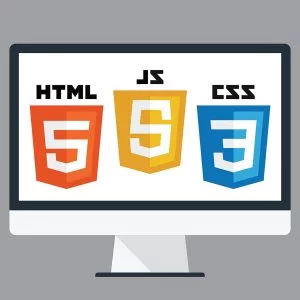
In this course we’re going to look at GLSL ( OpenGL Shading Language) to create amazing effects.
Maybe you are
a designer who has seen some terrific, cutting edge websites using cool transitions and wondered how it was done. You may have heard about WebGL and know that you can use some simple THREE.js code to do some remarkable things.
a developer trying to visualise some data in a striking way.
a game developer wanting to add some custom effects to your 3d objects surfaces.
GLSL is how you can use OpenGL to display a surface. The code syntax is based on the C language, but fear not, we will assume you have literally no knowledge of this language at all and we will, as the course title states, learn this from scratch. GLSL uses the GPU ( the Graphics Processing Unit) to handle multiple programs at the same time, so it is unbelievably fast.
In the course we will be writing code for the browser, because this allows us to focus on GLSL, without needing to worry about installing any additional software. We will be using the THREE.js WebGL library and CodePen so you can instantly edit the source and see the results, needing nothing other than a browser to experiment. Only a small amount of Javascript is used but this will be explained thoroughly as it comes along. But you can also use what you learn about GLSL in a C/C++/C# program or a Python program.
Instructor Details
Courses : 6
Specification: Learn GLSL Shaders from Scratch
|
23 reviews for Learn GLSL Shaders from Scratch
Add a review Cancel reply
This site uses Akismet to reduce spam. Learn how your comment data is processed.

| Price | $15.99 |
|---|---|
| Provider | |
| Duration | 4 hours |
| Year | 2022 |
| Level | All |
| Language | English |
| Certificate | Yes |
| Quizzes | Yes |

$79.99 $15.99






Baptiste Lyet –
I came here interested in making a custom lighting shader on an obj model, and I really found answers to my questions and more. The two faced aspect of the lessons and the codepen sketchs is great. I thank you !
Darko Draskovic –
A great course! Methodical, step by step explanations not only of the GLSL but also of the general theory behind shaders, usable with any shader system. Essential if you are into computer graphics or generative art. Thank you!
Derick Welman –
Come ou muito bem. O professor tem uma tima orat ria
Scott _ –
I’ve tried to pick up shaders in the past but found it quite difficult. Unlike other resources I’ve found, this course was the course that finally helped me get a much better grasp of glsl. It is well structured and very informative. I would recommend it to anyone looking to pick up glsl.
Scott –
I’ve tried to pick up shaders in the past but found it quite difficult. Unlike other resources I’ve found, this course was the course that finally helped me get a much better grasp of glsl. It is well structured and very informative. I would recommend it to anyone looking to pick up glsl.
Paul Karlik –
So far the intro is what I expected, for me mostly remedial some new things and also a little bit of oh yeah that’s why that is.. xy or z.
Leandro Ubilla Gonzalez –
Everything is very well explained, it’s the glsl course for beginners I was looking for.
Matt –
very good course!
ec–ccs –
ANOTHER good course by Nik. He correctly selected a set of simple but interesting issues in GLSL, and presented them clearly using well prepared resources, emphasising code along lessons, and proposing nice challenges. This course is different to his more advanced ones so it fits more an All Levels audience. This is certainly a good COOKBOOK that will help you clarify some basic GLSL concepts and applications.
ec ccs –
ANOTHER good course by Nik. He correctly selected a set of simple but interesting issues in GLSL, and presented them clearly using well prepared resources, emphasising code along lessons, and proposing nice challenges. This course is different to his more advanced ones so it fits more an All Levels audience. This is certainly a good COOKBOOK that will help you clarify some basic GLSL concepts and applications.
Eraince Wang –
The starting of this course is really clear and helpful. I really got to understand how shader works and how the mindset should shift from serial programming to parallel programming. However, as he went through more complicated examples, the explanation is not so clear. He did try to explain it really quickly, but given it is not a simple topic, I really think the instructor can spend more time explaining why instead of showing what exactly the code should look like.
Jose Conchello –
at least the first few episode, the code doesnt match. It would be nice to know where we are supposed to be starting, which shader file
ninonoids –
From what I’ve watched so far, it is well explained and and has a good pace.
Nicolas Garay –
The course is definitely simple to digest, the instruction is clear, and the problems relevant. I have worked with WebGL in the past but topically, never really understanding GLSL. Now, I understand what they do, how they do it, and how to use them.
David Fitzgibbon –
Could really do with fully explaining where some of the calculations come from. I get that some things are just tinkering, but what numbers arent just tinkering? Where did you find them?
Nikolay Odintsov –
Complexity and clarity of the course is changing linear from 1 to +1 🙂 It starts very clear and easy and then turns into unclarity. I would slow down on some topics. Another thing I would advise is to not just pronouncing numbers when typing code but to say what they mean. It will be more meaningful and would help a lot. I’ve got some knowledge from this course, but many things are still not clear. A mixed feeling of it. I can’t say it is great.
Anh Mac Van –
The same as other people, the starts of the course is really helpful for beginner graphic developer, however, from the section noise, everything is going to fast, a lot of functions, sin cos math. I hope you will have another math course.
Simone Seagle –
This is fun! I was hoping for something with more advanced material since I’ve already been through the whole Book of Shaders, but this is a nice review and hopefully sections 5 8 will have some more new information for me!
David Allen –
I’ve been struggling through shaders the past few weeks and trying to deconstruct examples I found online. I’m about 25% finished with this course and I’ve already learned valuable things that I’ve been looking for but couldn’t find.
Renaud Collet –
Clear and concise explanations, short and well organized videos. I’m only at section 3 but really recommend this course so far.
Megan Zhu –
very pragmatic with quick summary of fundamentals. Great instructor
Renato Campos Mauro –
Sim, excelente e did tico.
Hakan Bilgic –
This course is pretty good if you are a little familiar with the stuff and Mr. Lever does an excellent job to lead you over difficult topics and makes you more intrested to learn about it. If you do not have some knowledge about the topics like GLSL, Shaders etc. it could confuse you. I would like to give this course 4 or 5 stars but there is missing some more content to confirm the new knowledge for the student. I prefer quality for qantity for sure but for 5 stars I think there could be more explanations and examples. This was a good refresher and I have learned new things. All in all I would recommend this course for people who worked with shaders or maybe with three.js and have already written their own shaders. But who are not familiar with these topics could have problems. Good course. You will new things and Mr. Lever explained the things in that way so I was able to see things from different angles and sides. With more content and more topics this course could be excellent and then I am ready to give 5 stars.